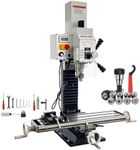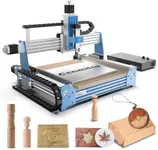Buying Guide for the Best Benchtop Mill
Choosing the right benchtop mill can be a daunting task, but with the right approach, you can find the perfect fit for your needs. A benchtop mill is a versatile tool used for precision machining of metal, wood, and other materials. When selecting a benchtop mill, it's important to consider several key specifications to ensure it meets your requirements. Understanding these specs will help you make an informed decision and get the most out of your investment.Spindle SpeedSpindle speed refers to how fast the spindle rotates, measured in revolutions per minute (RPM). This is important because different materials and cutting tools require different speeds for optimal performance. Lower speeds (0-2000 RPM) are suitable for harder materials like steel, while higher speeds (2000-5000+ RPM) are better for softer materials like aluminum or wood. Choose a mill with a variable speed range that matches the materials you plan to work with most frequently.
Table SizeThe table size is the surface area where you place your workpiece. A larger table provides more space for bigger projects and allows for more flexibility in positioning your workpiece. If you plan to work on small, detailed projects, a smaller table may suffice. However, for larger or more complex projects, a bigger table will be beneficial. Consider the size of the projects you intend to undertake when selecting the table size.
Travel DistanceTravel distance refers to the maximum movement of the mill's table in the X (left-right), Y (front-back), and Z (up-down) directions. This is crucial for determining the size of the workpiece you can machine. Mills with longer travel distances can handle larger workpieces and more complex operations. If you plan to work on larger projects, look for a mill with greater travel distances. For smaller, more precise work, shorter travel distances may be adequate.
Motor PowerMotor power, measured in horsepower (HP), determines the mill's ability to cut through materials. Higher horsepower means more cutting power, which is essential for working with harder materials. For light-duty tasks and softer materials, a motor with 0.5-1 HP may be sufficient. For more demanding tasks and harder materials, look for a motor with 1.5 HP or more. Match the motor power to the type of materials and the intensity of the work you plan to do.
Precision and AccuracyPrecision and accuracy are critical for achieving high-quality results. This spec is influenced by the mill's build quality, rigidity, and the precision of its components. Look for mills with high-quality construction and features like digital readouts (DRO) for precise measurements. If your projects require tight tolerances and fine details, prioritize mills known for their precision and accuracy. For less demanding tasks, a standard level of precision may be acceptable.
Ease of UseEase of use encompasses the mill's user interface, controls, and overall ergonomics. A mill that is easy to operate will save you time and reduce the learning curve, especially if you are a beginner. Features like intuitive controls, clear instructions, and convenient adjustments can make a big difference. Consider your experience level and how comfortable you are with operating machinery when evaluating ease of use.
Build Quality and DurabilityBuild quality and durability determine how long the mill will last and how well it will perform over time. A well-built mill made from high-quality materials will withstand heavy use and maintain its accuracy. Look for mills with sturdy frames, reliable components, and good reviews regarding their longevity. If you plan to use the mill frequently or for heavy-duty tasks, prioritize build quality and durability to ensure it can handle the workload.







![RIEDHOFF X-Axis Power Milling Machine, [450 LB Torque ] Power Feed Table Mill,110V, 0-200PRM Adjustable Rotate Speed for Bridgeport and Similar Knee Type Milling Machines,White](https://images-proxy.bestreviews.guide/Af-RQqwk1_ud8_yIY3GPPs0gcMw=/0x150/https://m.media-amazon.com/images/I/41UHXMx+9XL._AC_CX679_.jpg)
![Garvee X-Axis Power Feed for Power Milling Machine, [450 LB Torque]110V, 0-200PRM Adjustable Rotate Speed for Bridgeport and Similar Knee Type Milling Machines](https://images-proxy.bestreviews.guide/gDeMw39XZPsnrvYbIkjeOJ0qa-E=/0x150/https://m.media-amazon.com/images/I/41N1fxmEFDL._AC_CX679_.jpg)



